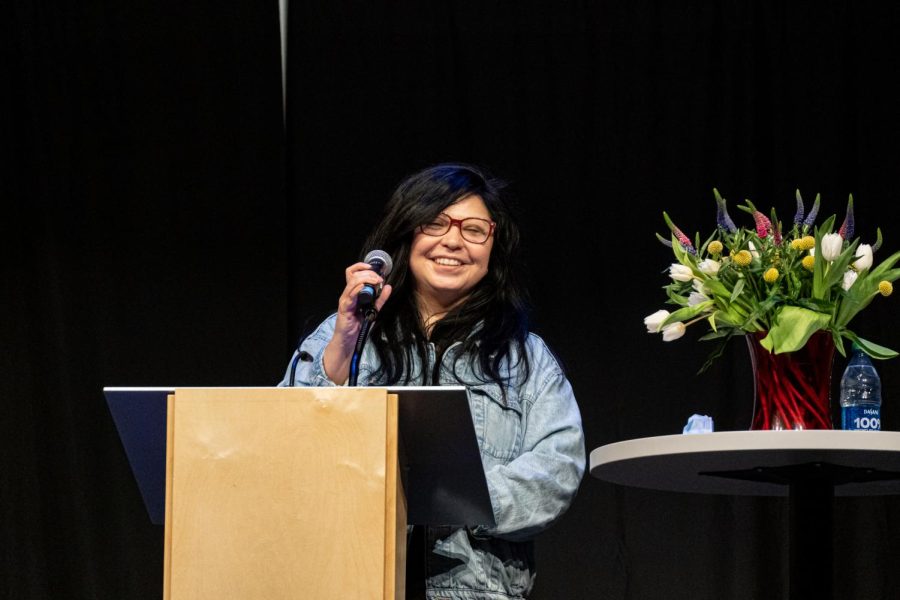Columbia welcomes Indigenous artists to amplify Native voices
April 26, 2023
Two Indigenous artists visited Columbia in events that were part of Columbia’s new series “Listening to Indigenous Voices,” hosted by the English and Creative Writing Department.
New York Times best-selling author Terese Mailhot read from her memoir, “Heart Berries,” and signed copies on Thursday, April 20, at the Student Center. On Friday, April 21, multimedia visual artist Debra Yepa-Pappan spoke about her work with the Field Museum to create Native American exhibits that accurately portrayed the culture.
The goal of the events is to increase the “air time” of Native American people in the school, said Jeanne Petrolle, acting chair of the English and Creative Writing department.
“We simply don’t study history enough from a Native American perspective,” Petrolle said. “In order to understand history truthfully, we need the perspectives of Indigenous writers and artists so we can understand our actual history and where we actually live.”
Carolina Ayala, a senior creative writing major, helped secure the grants to fund the events. They gave an introductory speech for Mailhot and said their work inspired them.
“I was hungry for lives that looked like mine; starving for words that felt familiar,” Ayala said.
As an Indigenous Mexican, Ayala wanted to start an Indigenous students group on-campus before they graduated this spring. They hope to connect with Indigenous professor Luanne Redeye to organize the group after Ayala graduates.
After reading two excerpts from her memoir, Mailhot answered audience questions. She discussed her writing process and how she gained the confidence to share her work under the pressure of being in a predominately white institution.
“Sometimes you’re truly magnificent and people don’t want to witness it, especially Native women,” Mailhot said. “When we have talent, it is threatening because we talk about land back; we talk about murdered and missing Indigenous women; we talk about disparity.”
Yepa-Pappan spoke to Columbia students about confronting stereotypes of Indigenous people through art. Chicago’s Field Museum had an exhibit displayed for over 50 years that did not accurately portray Native Americans.
Yepa-Pappan said she was embarrassed by the museum’s exhibit but then found herself helping them renovate the Native American hall.
“I kicked in the door to get into the museum so that I could hold that door open for other Native people to come in,” Yepa-Pappan said. “They have a lot of our things there in the museum and we need access to that. Those are our relatives. Those are our ancestors and we need to connect with them.”
Her non-profit Center for Native Futures is an art gallery that will feature Native artists and host programs. The center is set to open this fall in the Marquette building downtown.
“We want to provide a home for those Native students that come to Columbia or the School of the Art Institute,” Yepa-Pappan said. “There are always a few, but they are always there.”
The first event, held on March 17, featured Indigenous advocate Meranda Roberts. The event series was funded by grants obtained by Columbia’s offices of Academic Diversity, Equity and Inclusion and Student Diversity and Inclusion.
More programming highlighting Indigenous voices is being planned for next year, Petrolle said. A “super special guest” is in the works, but the school is waiting on the grant to lock that in.
Ayala said the goal of creating an Indigenous group and events is to acknowledge the European influence that is upon the school, from the roots of English departments to the name Columbia being named after Christopher Columbus.
“It’s important that not only do we talk about these things, but that it’s someone like me that’s talking about these things,” Ayala said.
Ayala said they want the Indigenous student group to participate in Columbia’s student council, networking and community events.
“It will become so much easier to continuously remind students that you are in Chicago — this is the land you’re on, this is the air you’re breathing, this is where your art is being created,” Ayala said.








